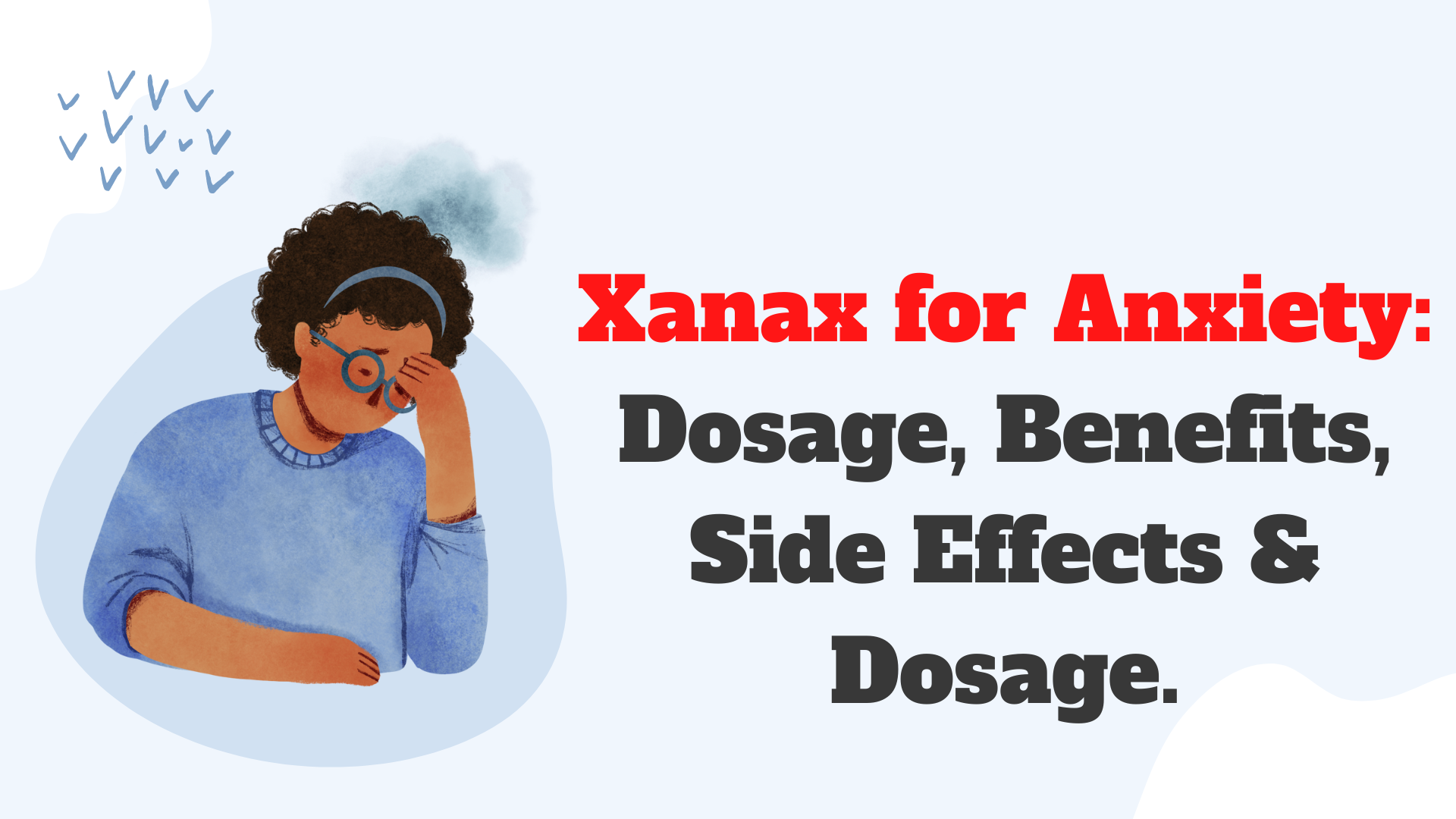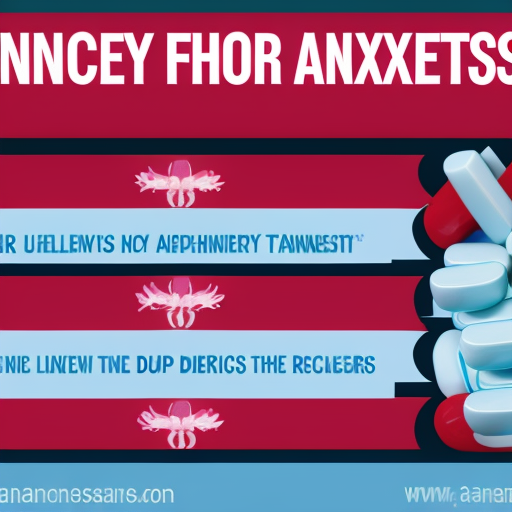Uncategorized
Dosage, Benefits, and Side Effects of Xanax for Anxiety – No RX ChatGPT Pharmacy
Anxiety and Its Types
Anxiety is a natural response of the body to stress triggers, usually situation-based. While short-term anxiety is a common phenomenon of stress or worry, extreme and prolonged anxiety can hinder day-to-day tasks and require medical attention. Anxiety disorders can take various forms, including phobia, social anxiety disorder, separation anxiety disorder, panic disorder, obsessive-compulsive disorder, post-traumatic stress disorder, and depressive disorders. Identifying the cause of concern is crucial to determine the appropriate line of treatment in consultation with a doctor.
Identifying Anxiety Symptoms
Anxiety and panic are often used interchangeably and can be mistaken for simple stress or worry. Symptoms of anxiety include anxious thoughts or beliefs that seem impossible to control, fatigue, trouble concentrating, restlessness, thoughts that are difficult to control, difficulty falling asleep, and irritability. Multiple causes or triggers for anxiety exist, such as stress, medical issues, genetic predisposition, particular surroundings or situations, substance use, or abuse.
Treatment for Anxiety Disorders
In cases of excessive anxiety that makes it difficult to continue with day-to-day activities, doctors may prescribe medication to treat anxiety. Psychotherapy with behavior change may not be enough to treat overwhelming anxiety. Different anti-anxiety pills are available based on the severity of the condition. The most common medication for anxiety and panic disorders prescribed in the US is Xanax.
Understanding Xanax
Xanax is the brand name for alprazolam and is prescribed to patients with anxiety and panic disorders. It is a part of medication known as benzodiazepine, which enhances the effects of a naturally occurring chemical in the brain. Xanax is available in multiple strengths, from 0.25mg to 3mg. Xanax works to alleviate symptoms of anxiety and panic disorders and is a level II controlled substance which means that it has a high potential for abuse.
How Xanax Works
Xanax is a benzodiazepine that increases the effects of the neurotransmitter GABA or Gamma-aminobutyric Acid. GABA is known to work as an inhibitory neurotransmitter that blocks or inhibits the ability of nerve cells to initiate, send, or receive chemical signals or messages. Xanax reduces the excitability and abnormal activity in the brain caused by anxiety. Low levels of GABA indicate stress, anxiety, and even epilepsy which. Xanax increases GABA levels, which causes a relaxed or calm feeling in the brain and body.
Possible Side Effects of Xanax
Common side effects of Xanax include drowsiness, dizziness, increased saliva production, change in sex drive, and feeling light-headed. These side effects should decrease with time. Severe side effects are unlikely but include severe and frequent mood changes, hallucinations, depression or thoughts of suicide, trouble speaking or walking, loss of coordination, and memory problems. Patients experiencing severe side effects should seek medical assistance immediately.
Precautions with Xanax Use
Xanax can be addictive and habit-forming, especially if patients have previously misused or abused any substance. It is advised that patients take their medication in moderation and inform their doctor if they think that the dosage prescribed to them isn’t working instead of increasing the dose on their own. Xanax can make patients drowsy or dizzy; they are advised to abstain from alcohol, cannabis products, and other CNS depressants that may worsen or aggravate their side effects.
Administration of Xanax
Xanax is orally administered to patients with anxiety and panic disorders. The dosage in generalized anxiety disorder is 0.25 to 0.5mg administered thrice daily with a maximum dosage of 4mg a day. For Panic disorder, the recommended dosage of Xanax is 0.5mg thrice a day with a maximum dosage of 10mg a day. The dosage of Xanax prescribed to patients will depend on their age, medical condition, and response to treatment. Xanax is a fast-acting mild tranquilizer and starts showing its effects within 30 minutes to relieve symptoms of anxiety and panic disorders.

Anxiety is the body’s natural response to stress triggers which in typical cases is situation based. You may feel anxious if you are about to give an important test or if you have an important meeting in the office, or if you are meeting someone after a very long time. Anxiety that lasts for a short period and is not frequent is a common phenomenon of stress or worry. However, if this anxiety is extreme and lasts for an extended period causing hindrance in your day-to-day tasks, you should consult a doctor.
Types of Anxiety Disorders
- Phobia – An excessive fear of a situation or objects like fear of elevators or spiders.
- Social anxiety Disorder – The fear of being judged by people in social situations
- Separation Anxiety Disorder – Fear of someone being out of sight. Most common in children and pets
- Panic Disorder – Recurring Panic attacks where you have trouble breathing or a tingling sensation in your body at unexpected intervals
- Obsessive-compulsive Disorder – Having irrational thoughts that cause you to obsess over a task or behavior repeatedly.
- Post-traumatic stress disorder – Anxiety caused due to a traumatic event which is common among soldiers who have faced war.
- Depressive Disorders – Depression, in most cases, is accompanied by anxiety and forms a vicious circle.
How can you Identify anxiety?
Anxiety and Panic are often interchangeably used and can also be mistaken for simple stress or worry.
Symptoms of Anxiety include-
- Anxious thoughts or beliefs that are seem impossible to control
- Fatigue
- Trouble concentration
- Restlessness
- Thoughts that are difficult to control
- Difficulty falling asleep
- Irritability
There can be multiple causes or triggers for anxiety like stress, medical issues, genetically acquired, particular surroundings or situations, substance use, or abuse. Identifying the cause of concern is crucial so you can determine a line of treatment in consultation with your doctor.
In cases of anxiety that is excessive and makes it difficult to continue with day-to-day activities, doctors may prescribe medication to treat anxiety. Anxiety can sometimes be overwhelming, and psychotherapy with behavior change may not be enough to treat it. There are multiple anti-anxiety pills available due to the commonality of the disorders with time. Different strengths based on the severity of the condition are prescribed. The most common medication for anxiety and panic disorders prescribed in the US is Xanax.
What is Xanax?
Xanax is the brand name for alprazolam and is prescribed to patients with anxiety and panic disorders. It is a part of medication known as benzodiazepine, which enhances the effects of a naturally occurring chemical in the brain. Xanax is available in multiple strengths, from 0.25mg to 3mg. Xanax works to alleviate symptoms of anxiety and panic disorders and is a level II controlled substance which means that it has a high potential for abuse. It is advised that you keep your prescription away from the reach of others, especially children.
How does Xanax function?
Xanax is a benzodiazepine that is responsible for increasing the effects of the neurotransmitter GABA or Gamma-aminobutyric Acid. GABA is known to work as an inhibitory neurotransmitter that blocks or inhibits the ability of nerve cells to initiate, send or receive chemical signals or messages. Your body goes into an excited state when you are anxious, and Xanax works to reduce the excitability and abnormal activity in the brain. Low levels of GABA indicate stress, anxiety, and even epilepsy which. Xanax increases GABA levels, which causes a relaxed or calm feeling in the brain and body.
What are the possible side effects caused by Xanax?
The common side effects are-
1- Drowsiness
2- Dizziness
3- Increased Saliva production
4- Change in sex drive
5- Feeling Light Headed
The common side effects of Xanax should decrease with time. It is advised that you inform your doctor if they get worse.
The severe side effects include-
1- Severe and frequent mood changes
2- Hallucinations
3- Depression or thoughts of suicide
4- Trouble speaking or walking
5- Loss of coordination
6- Memory problems
The severe side effects are unlikely and are rarely noticed in patients. However, if you see any severe side effects, you should immediately look for medical assistance.
Precautions to be taken while using Xanax
Xanax can be addictive and habit-forming, especially if you have previously misused or abused any substance. It is advised that you take your medication in moderation. If you have used Xanax for a long time, you may develop dependence or tolerance to it, and it is advised that you inform your doctor if you think that the dosage prescribed to you isn’t working instead of increasing the dose on your own. Xanax can make you drowsy or dizzy; you are advised to abstain from alcohol, cannabis products, and other CNS depressants that may worsen or aggravate your side effects.
How should you take Xanax?
Xanax is orally administered to patients with anxiety and panic disorders. The dosage in generalized anxiety disorder is 0.25 to 0.5mg administered thrice daily with a maximum dosage of 4mg a day. For Panic disorder, the recommended dosage of Xanax is 0.5mg thrice a day with a maximum dosage of 10mg a day. The dosage of Xanax prescribed to you will depend on your age, medical condition, and response to treatment. Xanax is a fast-acting mild tranquilizer and starts showing its effects within 30 minutes to relieve symptoms of anxiety and panic disorders.

 Skip to content
Skip to content


